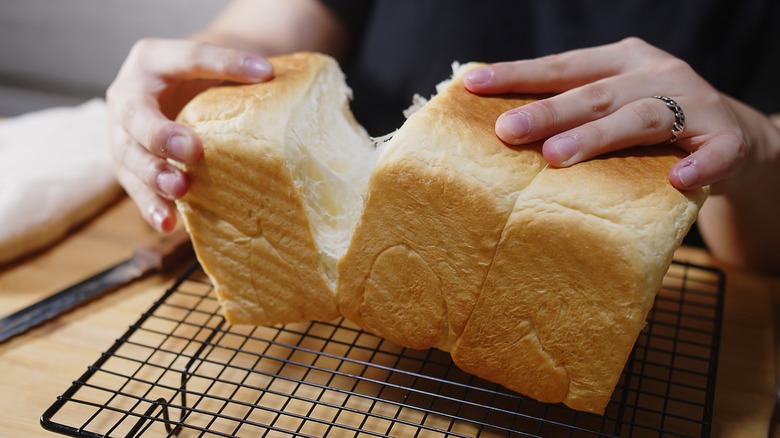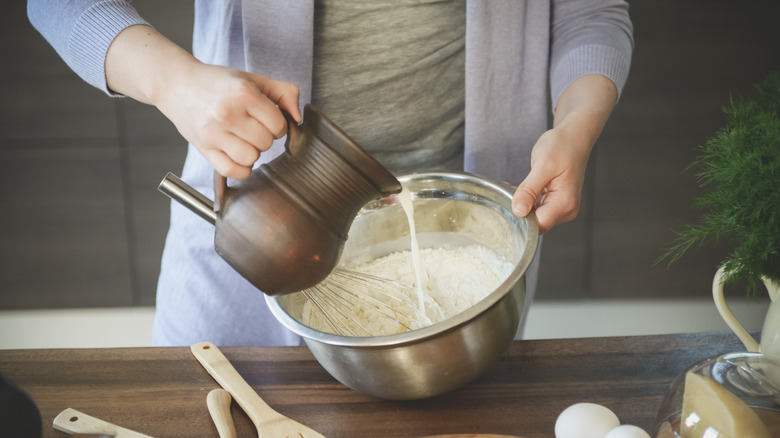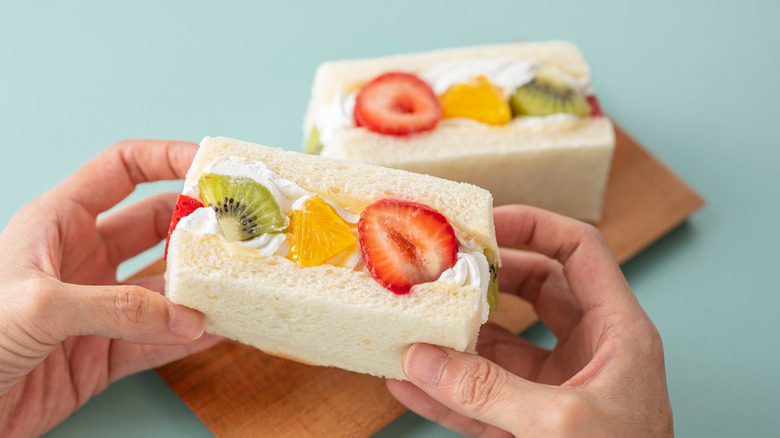The Secret To Getting The Buttery Soft Texture Of Milk Bread
As far as bread trends go, Japanese milk bread could give sourdough a run for its money — or rather, its dough. These exceptionally soft, light, and mildly sweet loaves, called shokupan in Japanese, may look like standard loaves of white bread, but the texture and flavor is far more ethereal and cloud-like. Of course, the ingredients matter when creating milk bread, but the key to obtaining that unmistakable pillowy softness is a method called yudane.
Yudane is a Japanese technique of scalding flour by whisking it with boiling water or milk, until the mixture is smooth and thickened. A similar method called tangzhong is used to make a fluffy bread called pai bao, which is popular in Hong Kong, but the flour scald is usually cooked over the stove in that case. Ultimately, both yudane and tangzhong are used to make bread that keeps its soft texture for a longer period of time.
Once the yudane mixture is made, butter is added to the still-warm combination — which should have a pudding-like consistency — so that it melts, and adds to the buttery flavor and soft texture of the bread. Milk bread can be difficult to find in countries besides Japan, and expensive when you do stumble upon it, but with a little practice, you can make and enjoy this highly-coveted bread anytime you'd like.
The science behind yudane
As with everything in baking, the texture of milk bread is the result of science in action. The yudane technique essentially works to hydrate and soften the starch in the bread (which comes from flour) with a liquid (milk or water). When heat is added, the starches absorb even more liquid, making them swell with moisture. This is essential to that fluffy, moist, and soft consistency.
Certain flours will make softer loaves of milk bread, too. While wheat flour is perfectly fine to use, it contains a larger portion of a starch molecule called amylose, which is what eventually makes bread go stale. Wheat also contains another molecule called amylopectin, which keeps bread soft, but amylose can quickly overpower amylopectin in 100% wheat loaves. On the other hand, alternative flours like sweet rice flour contains almost 100% amylopectin, which produces a loaf of bread that stays softer for longer.
Aside from the scalded flour mixture, milk bread is typically made of butter, eggs, sugar, salt, and yeast, and is baked in loaf pans for its signature tall and square shape. The loaves are often brushed with more butter as soon as they come out of the oven for a gorgeous shiny crust and more of that rich flavor. For amateur bakers, perfectly soft bread that pulls apart into cottony chunks might take a few attempts, but nailing the yudane method (and learning how your oven behaves via trial and error) will eventually produce success.
The best ways to enjoy milk bread
In Japan, shokupan is the bread of choice for making sandos, little sandwiches sold at convenience stores, school lunch, and at home. Milk bread is a must-have for Japanese egg sandwiches, which are arguably the most scrumptious egg salad sandwiches on the planet. Sliced milk bread is also often filled with katsu (fried meat cutlets), or sweetened whipped cream with fresh fruit for a fruit sando (the result is like biting into a lightly-sweetened cake).
You can treat milk bread like any other sandwich bread, but it's so delicate and unique that you'll want to make sure nothing overpowers it. A simple peanut butter and jelly or ham and Swiss cheese sandwich will suddenly become so delicately sweet and fluffy that you'll want to savor every bite. You can toast a slice of milk bread and make avocado toast, or simply smear some good butter and jam on top.
If you notice that your loaf is starting to lose its softness, it will make for some unforgettable French toast, especially if you oven-roast the bread first. Of course, if you polish off half the loaf as-is the minute it comes out of the oven, there's no shame — anyone who has tried milk bread will completely understand.



